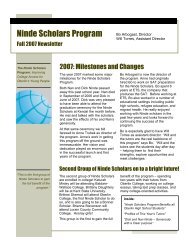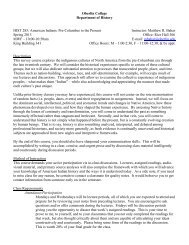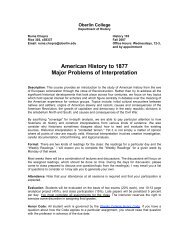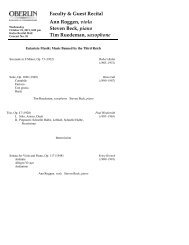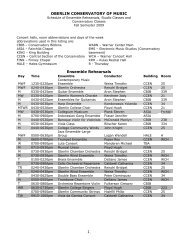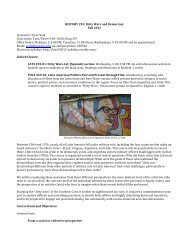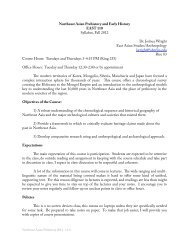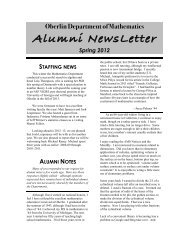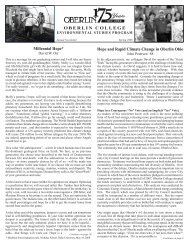SOCI 338 Syllabus Spring 2010
SOCI 338 Syllabus Spring 2010
SOCI 338 Syllabus Spring 2010
You also want an ePaper? Increase the reach of your titles
YUMPU automatically turns print PDFs into web optimized ePapers that Google loves.
Prostitution and Social Control Greggor Mattson<br />
<strong>SOCI</strong> <strong>338</strong> <strong>Syllabus</strong> * <strong>Spring</strong> 210 King 341, MWF 1:30pm<br />
Prostitution is a site of easy truths and inevitable conflict because of cultural ambiguities about<br />
sexuality, gender, ethnicity and citizenship. We probe these intersecting meanings by reviewing<br />
the wide range of empirical meanings attributed to prostitution and the ways modern forces have<br />
transformed them, especially the state. Taking cues from Michel Foucault, we analyze why<br />
recent legal solutions cannot fulfill expectations and discuss how the social control of<br />
prostitution might actually cause it.<br />
The course is a core course in Law and Society (LAWS) and Gender, Sexuality and Feminist<br />
Studies (GSFS), is writing intensive (WR) and fulfills the cultural diversity requirement (CD).<br />
Required Texts:<br />
Wardlow, Holly. 2006. Wayward Women: Sexuality and Agency in a New Guinea Society. 1st<br />
ed. University of California Press.<br />
Weitzer, Ron. 2009. Sex For Sale: Prostitution, Pornography, and the Sex Industry. 2nd ed.<br />
Routledge.<br />
Agustin, Laura Maria. 2007. Sex at the Margins: Migration, Labour Markets and the Rescue<br />
Industry. London: Zed Books.<br />
Bernstein, Elizabeth. 2007. Temporarily Yours: Intimacy, Authenticity, and the Commerce of<br />
Sex. University of Chicago Press.<br />
Brennan, Denise. 2004. What's Love Got to Do With It?: Transnational Desires and Sex Tourism<br />
in the Dominican Republic. Duke University Press.<br />
Padilla, Mark. 2007. Caribbean Pleasure Industry: Tourism, Sexuality, and AIDS in the<br />
Dominican Republic. 1st ed. University Of Chicago Press.<br />
Contact info<br />
greggor.mattson@oberlin.edu<br />
Mailbox on my door, King 305c<br />
Office hours: Mon 2:30-3:30pm; Wed 10am-11am; by appointment<br />
Assessment<br />
Participation in discussion: 20<br />
Reading memos 40 (do 8, I will drop the lowest score)<br />
Documentary review 10<br />
Final Paper 30<br />
Participation (in 6 easy steps)<br />
• Read the texts before class and take notes on them<br />
• Bring the texts and your notes to class<br />
• Come to class on time every time<br />
• Actively participate in discussions<br />
• Open laptops only in the front rows<br />
• Be respectful to others
Your on-time attendance is essential to your ability to participate. If you miss, get notes from a<br />
colleague and come to office hours with questions about the material you missed. Provide<br />
documentation at least two weeks before absences for approved College events.<br />
My goals for you are to learn<br />
• how cultural ambiguities make prostitution a ready site of truth and cultural conflict<br />
• how processes of modernity transformed prostitution, especially via the state<br />
• a wide range of meanings attributed to prostitution<br />
• why none of the new policy solutions can fulfill their expectations<br />
Reading Memos<br />
Submit reading memos before the class. You are responsible for turning in reading 2-3 pages of reading<br />
memos each week for the first half of the course. Note: everyone must do a reading memo for week 2 of<br />
the course. Reading memos consist of two parts: a succinct summary of the argument and evidence in<br />
that week’s readings and your reactions to them. Reactions can take the form of evaluations of the<br />
arguments, methodological considerations, ties to other pieces we have read, personal reflections, or<br />
questions for discussion.<br />
One way to think about them is to imagine you are a reviewer of a book containing only that week’s<br />
readings or that you’re explaining them to an interested friend. What are they about? Why are they<br />
important? What is missing in them?<br />
Submit the readings electronically before the class period for which the readings were due. There<br />
are no late memos and no extensions.<br />
Reading Tips<br />
Read the lecture headings – they tell you the purpose of the reading. Skim each of the texts in 5<br />
minutes. Notice section headings, bold words, or highlighted quotations to get the story the<br />
author is telling. When you read the whole thing, you’ll know where the argument is going.<br />
Movie Review<br />
OhioLink gives us access to a huge collection of documentaries about prostitution that you can watch for<br />
free. Since I can’t see everything, 10% of your grade will be to write a short (2-page) review of one<br />
documentary or two commercial release films, how they fit in to our readings, and what you learned<br />
from them. After you receive comments, upload your documentary to a site of reviews and send me the<br />
link.<br />
Final Paper<br />
Use your memos as the building blocks to synthesize the readings from the class as evidence for<br />
an argument about prostitution in the Dominican Republic. Your final paper is an 8-10 page<br />
scholarly review of the Brennan and Padilla books. A scholarly review takes a position on the<br />
texts, analyzing them from a point of view. You may choose any of the themes from the class to<br />
construct your thesis – gender, sexuality, power, money, cultural difference, citizenship, political<br />
economy, race, etc.<br />
Late Assignments
Late assignments will lose one letter grade for each day late – this includes not turning in a hard<br />
copy at the beginning of class. Excused lateness must come from a Class Dean.<br />
Honor Code: http://www.oberlin.edu/students/links-life/honorcode.html<br />
Sign the honor code on each assignment—it is your reminder to know the boundaries of cheating<br />
(not doing your own work) plagiarism (taking credit for someone else’s work) and fabrication<br />
(making up sources, quotations or observations). Refer to the honor code and/or talk to me if you<br />
have concerns or are feeling so pressed that cheating seems attractive.<br />
Disability Accommodations<br />
If you are a student with a disability, make sure you’ve registered with the Office of Disability<br />
Services (Peters G-27/28 x55588) to develop a plan to meet your academic needs. Bring their<br />
recommendations to me at least two weeks before any due date or exam.<br />
Grading rubric<br />
Papers will be graded as follows:<br />
Thesis sentence: 20 (UNDERLINED, answers how or why question appropriate to<br />
essay length. Yes, you get points for underlining it.)<br />
Organization 20 (ideas grouped in paragraphs, evidence for main points)<br />
Sources 30 (synthesizes a variety of texts, in-text citations in APA format)<br />
On time 10 (printed copy hand-delivered by beginning of class, all or nothing)<br />
Insight 10 (creativity, connections between texts, use of language, sparkle)<br />
Conventions 10 (stapled, grammar, 1” margins, spelling, punctuated, 12-pt. font)<br />
Sources & Citations (APA format)<br />
You need not make a works cited for course readings but you must cite them properly in the text<br />
in APA format. Wikipedia is not an academic source, but may lead you to primary sources.<br />
Paraphrasing primary sources (preferred):<br />
Media in the 1950s catered to the rising middle class, giving a misleading impression of<br />
America’s families (Coontz 1990, p. 31).<br />
Direct quotations (use sparingly) must be introduced:<br />
Stephanie Coontz cites the enduring power of the media for creating a new American<br />
tradition during the baby boom: “The happy, homogenous families that we ‘remember’<br />
from the 1950s were… a result of the media’s denial of diversity” (1990, p. 31).
<strong>Syllabus</strong><br />
Readings are due to be read by the date on which they are listed. Only a small portion of the<br />
FILMS listed will be shown in class; I list them for you to get into the spirit of the class on your<br />
own time, if you like (by putting them on your Netflix queue or watching them for free in the<br />
Media Resource Center, for instance).<br />
WEEK 1: THE LAY OF THE LAND: THE MEANINGS OF PROSTITUTION (Feb 8-12)<br />
1: First Day: Terms, Terms and Turns<br />
http://video.nytimes.com/video/2006/12/18/opinion/1194817092163/heartbreak-and-hope.html<br />
2: Read these three accounts of contemporary prostitution. Based on these very different<br />
experiences, what can we say about the category “prostitution”?<br />
Bourgois, Philippe, and Jeffrey Schonberg. 2009. Righteous Dopefiend. 1st ed. University<br />
of California Press.<br />
Barbara. 1993. “It's a Pleasure Doing Business with You.” Social Text 37:11-22.<br />
Sapphire. 1987. “New York City Tonight.” Pp. 125-130 in Sex Work: Writings By<br />
Women in the Sex Industry. Cleis Press: San Francisco.<br />
EXTRA: Bourgois, Philippe, and Eloise Dunlap. 1993. “Exorcising sex-for-crack: An ethnographic<br />
perspective from Harlem.” Pp. 97-132 in Crack Pipe As Pimp: An Ethnographic Investigation of<br />
Sex-For-Crack Exchanges. New York: Lexington.<br />
MOVIE: Pretty Woman (1991), Lilya-4-Ever (2002)<br />
3: The media and migrant prostitution, then and now. Read these two journalistic accounts<br />
separated by a century. What is similar, what is different? In other words: has the situation for<br />
poor women stayed the same? The public appetite for stories of destitution? Both? And/or<br />
something else?<br />
Read from “The Violation of Virgins” in The Maiden Tribute of Modern Babylon:<br />
http://www.attackingthedevil.co.uk/pmg/tribute/mt1.php (Stead, 1885)<br />
Kristof, Nicholas D. 2004. “Girls For Sale.” The New York Times, January 17<br />
Kristof, Nicholas D. 2004. “Bargaining For Freedom.” The New York Times, January 21<br />
Kristof, Nicholas D. 2004. “Going Home, With Hope.” The New York Times, January 24<br />
Kristof, Nicholas D. 2004. “Loss of Innocence.” The New York Times, January 28<br />
Kristof, Nicholas D. 2004. “Stopping The Traffickers.” The New York Times, January 31<br />
Kristof, Nicholas D. 2005. “Back to the Brothel.” The New York Times, January 22<br />
Kristof, Nicholas D. 2005. “Leaving the Brothel Behind.” New York Times, January 19<br />
MOVIE: Call + Response (2005), Taxi Driver (1976)<br />
WEEK 2: FEMINIST DEBATES AND LEGAL STRATEGIES (Feb 15-19)<br />
1: Prostitution debates fundamentally changed when prostitutes began organizing in the 1970s,<br />
speaking for themselves and This coincided with larger feminist debates about the meanings of<br />
gender, femininity, and sexuality that changed laws and public culture.
Alexander, Pricilla. 1987. “Prostitution: A Difficult Issue for Feminists.” Pp. 184-214 in<br />
Sex Work: Writings By Women in the Sex Industry. Cleis Press: San Francisco.<br />
“Sex Worker Self Advocacy,” Chapkis, Wendy. 1997. Live Sex Acts. New York:<br />
Routledge.<br />
“Wynter, Sarah. 1987. “WHISPER: Women Hurt in Systems of Prostitution Engaged in<br />
Revolt.” Pp. 266-270 in Sex Work: Writings By Women in the Sex Industry. Cleis<br />
Press: San Francisco.<br />
MOVIES: Live Nude Girls Unite! (2000), A Drug Called Pornography (2000), India Cabaret (1986)<br />
2: Compare these two very different analyses of the meanings of prostitution. What larger social<br />
forces do these theorists invoke to explain prostitution? Which do you find more convincing –<br />
why/why not?<br />
“Prostitution of Sexuality,” in Barry, Kathleen. 1995. The Prostitution of Sexuality: The<br />
Global Exploitation of Women. New York: New York University Press.<br />
Pheterson, Gail. 1993. “The Whore Stigma: Female Dishonor and Male Unworthiness.”<br />
Social Text 37:39-64.<br />
3: What is the relationship between the legal regimes discussed by Weitzer and the feminist<br />
debates we have been reading?<br />
Weitzer, Ronald John. 2009. “Sex Work: Paradigms and Policies.” Pp. 1-45 in Sex for<br />
Sale: Prostitution, Pornography, and the Sex Industry, 2nd Ed. New York:<br />
Routledge.<br />
Rubin, Gayle. 1975. “The Traffic in Women: Notes on the 'Political Economy' of Sex.”<br />
Pp. 157-210 in Toward an Anthropology of Women. New York: Monthly Review<br />
Press.<br />
WEEK 3: PROSTITUTION AND TRADITIONAL <strong>SOCI</strong>ETIES (Feb 22-26)<br />
1: What aspects of prostitution are culturally bound? What does sexual commerce look like in a<br />
country where the meanings of money, markets, legal regulation, and the state are very different<br />
from our own?<br />
Wardlow Wayward Women: “Introduction” (pp. 1-42; 105-29), “Tari is a Jelas Place,”<br />
and “Body and Agency Among Huli Women.”<br />
EXTRA: “The World’s Oldest Profession” Whelehan, Patricia. 2001. An Anthropological Perspective on<br />
Prostitution. Lewiston, NY: Edwin Mellen Press.<br />
MOVIE: Prisoners of a White God (2008), The Courtesans of Bombay (1983)<br />
2: Women in traditional exchange, women as modern individuals
Wardlow, “I am Not the Daughter of a Pig,” “Becoming a Pasinja Meri,” and “Passenger<br />
Women and Sexuality.”<br />
MOVIE: Prostitution Behind the Veil (2005)<br />
3: In what ways do modern conceptions of prostitution reproduce deep-seated cultural dualities?<br />
How is this similar or different to the New Guinean society analyzed by Wardlow?<br />
Wardlow, “Conclusion.”<br />
Ortner, Sherry B. 1974. “Is Female to Male as Nature is to Culture?.” Pp. 67-87 in<br />
Woman, Culture, and Society. Palo Alto, CA: Stanford University Press.<br />
MOVIE: At Stake (2008)<br />
WEEK 4: MODERNITY AND THE STATE (Mar 1-5)<br />
1: The rise of the social and the rise of the state: what are the implications for women, for the<br />
public sphere, and policing?<br />
“The Rise of the Social--and of 'Prostitution',” Agustin, Laura Maria. 2007. Sex at the<br />
Margins: Migration, Labour Markets and the Rescue Industry. London: Zed.<br />
Mattson, Greggor. 2008. “Governing Loose Women”<br />
2: Foucault and governmentality<br />
selection of “Introduction” to Foucault, Michel. 2000. Power: Essential Works of<br />
Foucault, 1954-1984, Volume III. edited by James D. Faubion, Paul Rabinow, and<br />
Colin Gordon. New Press.<br />
Foucault, Michel. 2000. “Governmentality.” Pp. 201-222 in Power: Essential works of<br />
Foucault 1954-1984. New York: The New Press.<br />
3: Paris, or How Prostitutes Are Like Sewers and Brothels Are Like Prisons<br />
Corbin<br />
Foucault<br />
EXTRAS: Emile Zola’s Nana (1880), Theodore Dreiser’s Sister Carrie (1900)<br />
MOVIE: Moulin Rouge (2001)<br />
WEEK 5: MODERNITY AND THE STATE (Mar 8-12)<br />
1: The extension of the state is one way to understand colonialism. In what ways is prostitution<br />
intrinsically racialized? What are the implications for these historical accounts for the women in<br />
Wardlow’s book?<br />
“Prostitution, Race and Empire” and “White Women’s Sexuality in Colonial Settings,”<br />
from Levine, Philippa. 2003. Prostitution, Race, and Politics: Policing Venereal<br />
Disease in the British Empire. New York: Routledge.
2: This article completes our discussion of the relationship between prostitution and modernity:<br />
the rise of the state and legal authority, the separation of sexuality from gender, and the rise of a<br />
middle-class public culture.<br />
Gilfoyle, Timothy J. 1999. “Prostitutes in History: From Parables of Pornography to<br />
Metaphors of Modernity.” The American Historical Review 104:117-141.<br />
3: Temporarily Yours<br />
Bernstein, “Sexual Commerce in Postindustrial Culture,” and “Remapping the Boundaries of<br />
‘Vice’”<br />
WEEK 6: AMERICAN SOLUTIONS TO PROSTITUTION (Mar 15-19)<br />
1: What does Luker mean when she says social reform is double-edged? In what ways does her<br />
analysis recall Emma Goldman’s critiques?<br />
Goldman, Emma. 1917. “The Traffic in Women.” Pp. 177-194 in Anarchism and Other<br />
Essays. New York: Dover Publications, Inc.<br />
http://www.gutenberg.org/files/2162/2162-h/2162-h.htm#traffic<br />
Luker, Kristin. 1998. “Sex, Social Hygiene, and the State: The Double-Edged Sword of<br />
Social Reform.” Theory and Society 27:601-634.<br />
2: Nevada: Global Anomaly<br />
Hausbeck, Kathryn and Barbara G. Brents. 2009. “Nevada’s Legal Brothels.” Pp. 255-<br />
282 in Sex for Sale.<br />
WEEK 7: PROSTITUTION AND MODERN LIFE (Mar 22-26)<br />
1: Prostitution and race<br />
Bernstein, “Modern Prostitution and Its Remnants”<br />
“The Setting,” “Sex, Race, Manhood and Womanhood,” from Milner, Richard B., and<br />
Christine Milner. 1972. Black Players: The Secret World of Black Pimps. New<br />
York: Bantam Books.<br />
2: Bernstein, “The Privatization of Public Women,” “Desire, Demand and the Commerce of<br />
Sex”<br />
3: “The State, Sexuality and the Market”<br />
Bernstein, “Sexuality Debates and Pleasure Wars”<br />
WEEK 8: WEEK EIGHT SPRING BREAK<br />
WEEK 9: CASE STUDY: DOMINICAN REPUBLIC via PADILLA (Apr 8-12)<br />
1: Global vs. Local Cultural Politics
Global Sexual Spaces and Their Hierarchies, “Looking for Life in the Dominican<br />
Pleasure Industry,” and “Shifting Cultural Politics of Sexual Identity in Santo<br />
Domingo”<br />
MOVIE: How Stella Got Her Groove Back (1998)<br />
2: Individuality & Agency vs. Tradition & Family: In what ways does Padilla’s story complicate<br />
the free/forced distinction in lay understandings of prostituion?<br />
“Familial Discretions, Unveiling the Other Side of Sex Work” and “Love, Finance, and<br />
Authenticity in Gay Sex Tourism.”<br />
3: How does Padilla’s political economy of risk contrast with a notion of risk grounded in<br />
individual choices and responsibility? What are the implications for AIDS interventions at the<br />
local level? The global?<br />
“AIDS, the ‘Bisexual Bridge,’ and the Political Economy of Risk in the Dominical Republic.”<br />
WEEK 10: CASE STUDY: DOMINICAN REPUBLIC via BRENNAN (Apr 15-19)<br />
1: Global vs. Local Cultural Politics: In what ways is the situation in Sosúa similar or different<br />
than in Padilla’s book? In what ways does gender impact the power dynamics in transnational<br />
prostitution?<br />
“Sosúa: A Transnational Town,” “Imagining and Experiencing Sosúa,” and “Performing<br />
Love.”<br />
2: The Sex Trade<br />
“Sosúa’s Sex Workers: Their Families and Working Life,” “Advancement Strategies in<br />
Sosúa’s Sex Trade.”<br />
3: Plan Accomplished<br />
“Transnational Disappointments,” and “Conclusion: Changes in Sex Workers’ Lives,<br />
Sosúa, and Its Sex Trade<br />
WEEK 11: TROUBLE WITH TRAFFICKING Apr 22-26)<br />
1: 1<br />
Agustin Chapters 1, 3<br />
Weitzer, Ronald, and Melissa Ditmore. 2009. “Sex Trafficking: Facts and Fictions.” Pp.<br />
325-351 in Sex for Sale.<br />
MOVIE: Sex Slave$ (2005)<br />
2: 2<br />
Agustin Chapters 6-7<br />
U.S State Department
3: 3<br />
Mattson, “The Trouble With Trafficking.”<br />
WEEK 12: THE U.S. WAR ON TRAFFICKING (May 1-5)<br />
1: DeStefano Chapters 1-6<br />
2: DeStefano Chapters 7-10<br />
3: DeStefano Chapters11-13<br />
WEEK 13: LOOSE ENDS (May 15-19)<br />
1: What about kids?<br />
Montgomery, Heather. 2003. “Children, Prostitution, and Identity: A Case Study from a<br />
Tourist Resort in Thailand.” Pp. 139-150 in Global Sex Workers: Rights,<br />
Resistance, and Redefinition. New York: Routledge.<br />
Zuilhof, Wim. 1999. “Sex for Money between Men and Boys in the Netherlands:<br />
Implications for HIV Prevention.” Pp. 23-40 in Men Who Sell Sex: International<br />
Perspectives on Male Prostitution and HIV/AIDS. Philadelphia: Temple<br />
University Press.<br />
MOVIE: Born Into Brothels (2004), Pretty Baby (1978)<br />
2: Ethics and ideology<br />
“Compromising Positions,” Chapkis, Wendy. 1997. Live Sex Acts. New York: Routledge.<br />
3: 3 Last Thoughts








